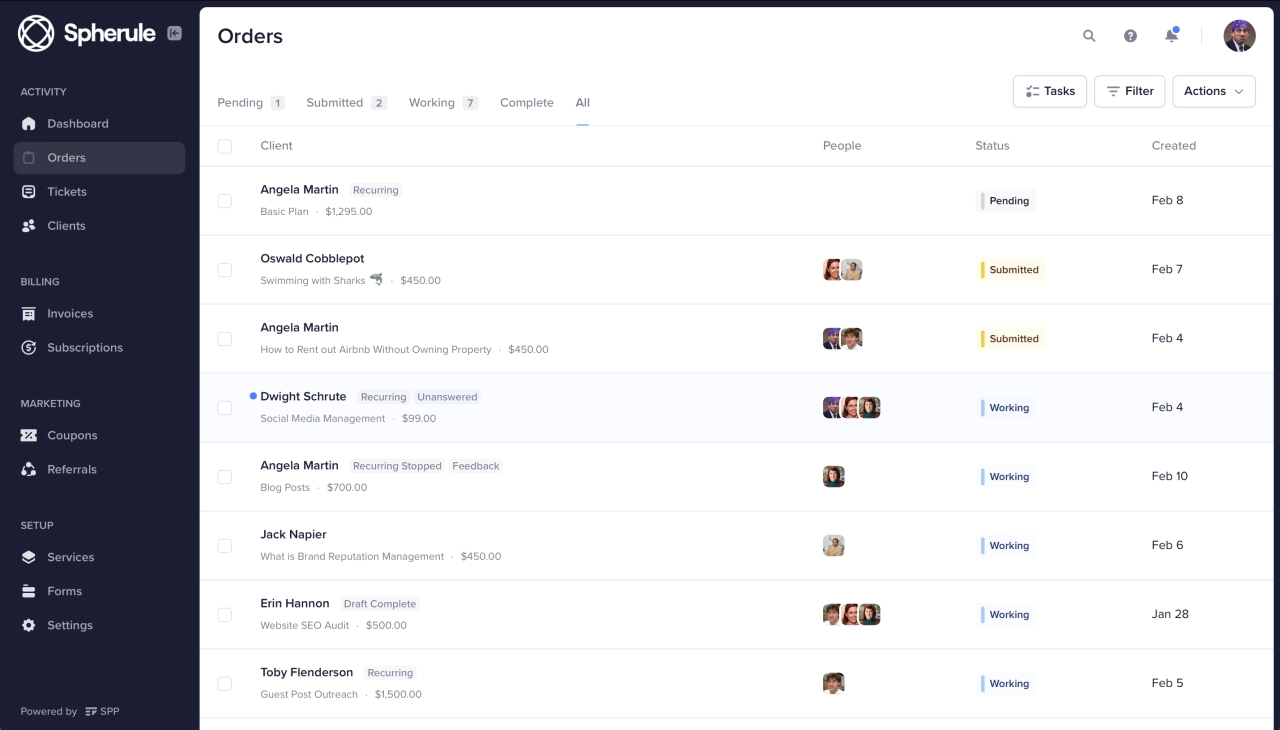- A competitive pricing strategy is easy to implement and allows businesses to adjust prices in real-time to respond to market changes, attract price-sensitive customers, and encourage healthy competition.
- It is important to consider factors such as production costs, profit margins, target audience preferences, brand image, and long-term goals when adopting it.
- While it may work well for businesses that sell standardized products or services, it may not be the best pricing method for service-based agencies that prioritize quality and expertise over price.
Nobody likes to endure the pain of losing clients to competitors. Yet, it’s a common scenario most business owners have experienced. You invest time and resources in nurturing a relationship only for the prospect to back out at the last minute because they got a better deal elsewhere. This is why many consider competitive pricing strategy as the best pricing strategy for staying in the game and maintaining market relevance.
While several factors influence client decisions, pricing significantly impacts whether you win or lose business. A well-implemented competitive pricing approach helps you avoid watching potential clients walk away to lower-priced competitors.
In this comprehensive guide, you’ll learn everything about implementing a successful competitive pricing strategy, including its benefits, potential pitfalls, and specific factors to consider for your service business.
What is a competitive pricing strategy?
A competitive pricing strategy is a pricing model where a business sets its prices based on what competitors charge for similar products or services. Unlike other pricing methods that focus primarily on costs or perceived value, competition-based pricing uses competitor prices as the primary benchmark for determining your own rates.
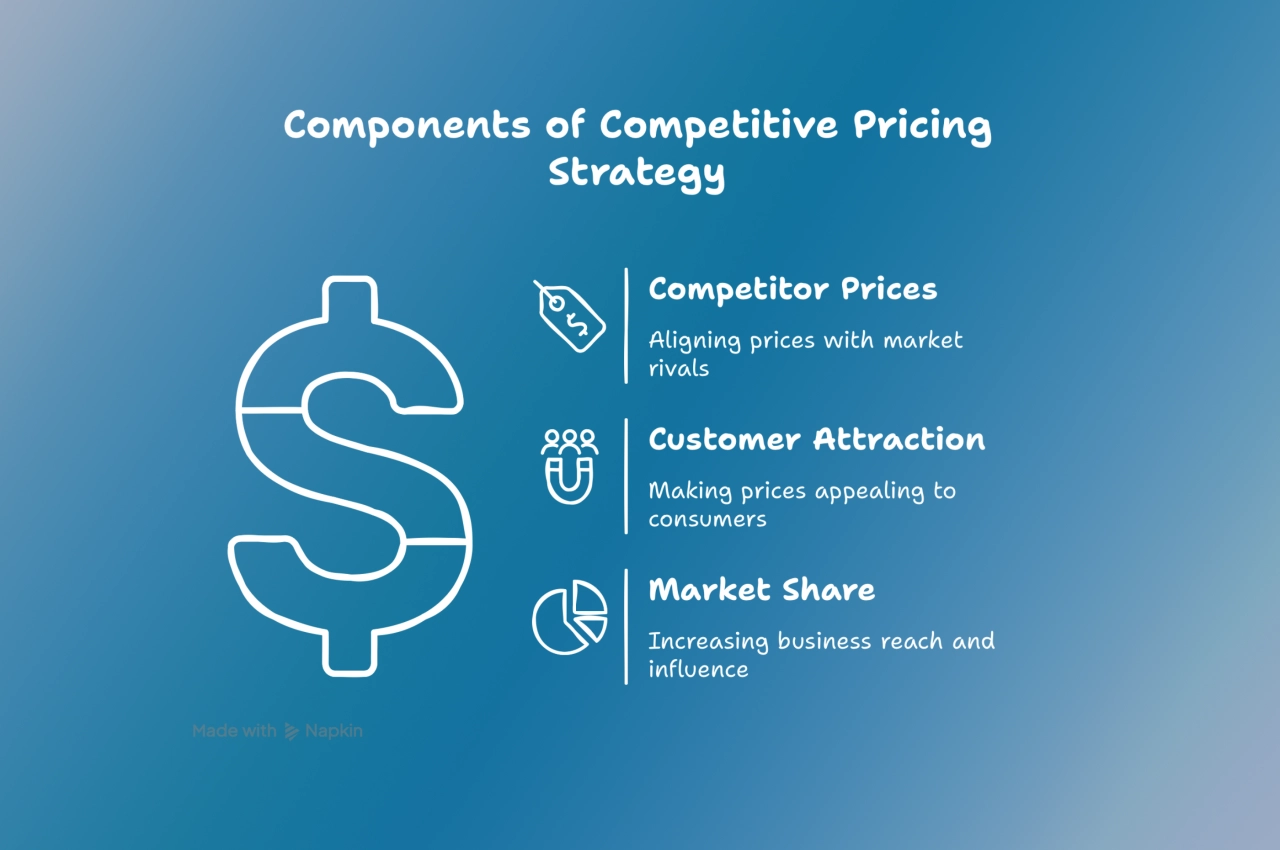
This approach can be implemented in several ways:
Matching competitor prices: Setting identical prices to your main competitors
Pricing below competitors: Deliberately undercutting competition to gain market share
Premium pricing: Setting prices higher than competitors to signal superior quality
Adaptive pricing: djusting prices in real-time as competitor prices change
For agencies and service businesses, this pricing strategy requires careful consideration. Unlike commodities with direct comparisons, services vary dramatically in quality, depth, and impact across different providers. For a content marketing agency, for instance, a $500 blog post can represent vastly different value propositions depending on the provider.
Benefits and disadvantages of competitive pricing
Before diving into implementation, it’s important to understand both the advantages and potential drawbacks of this pricing approach.
Benefits of competitive pricing
Understanding the advantages of competitive pricing can help you leverage this strategy to attract new clients, respond to market changes, and create a sustainable business model in even the most crowded markets.
Simple implementation
minimal research required compared to other pricing models
competitors have already done market testing
lower risk since you're using market-validated price points
Real-time market adaptability
quickly respond to market changes and competitor moves
adjust prices based on supply, demand, and competitive landscape
stay aligned with customer expectations
Attract price-sensitive customers
appeal to the majority of shoppers who prioritize getting a good deal
capture customers in the decision stage of the buyer's journey
remain competitive in price comparison scenarios
Compatibility with other strategies
combine with project-based pricing or fixed-cost approaches
create hybrid models that leverage competitive insights
adjust by service type or customer segment
Encourages healthy competition
stimulates continuous improvement in service quality
drives operational efficiency and innovation
creates dynamic market environments (think Uber vs. Lyft, Pepsi vs. Coke)
Disadvantages of competitive pricing
While competitive pricing offers many benefits, it’s equally important to recognize its potential drawbacks that could impact your profitability, brand positioning, and long-term business sustainability.
Sustainability challenges
potential race to the bottom with continuous price cutting
limited control over your own pricing strategy
may require continuous process optimization to maintain margins
Difficulty in differentiation
risk of commoditizing your services
challenge in communicating unique value propositions
may attract clients who only care about price
Profit margin pressure
may force you to operate with thinner margins
different operational costs than competitors can make their prices unsustainable for you
volume requirements to break even may be unrealistic
Brand perception concerns
potential misalignment with premium brand positioning
customer assumptions about quality based on price
challenge in raising prices later if initially set too low
Market research burden
requires continuous monitoring of competitor pricing
time-consuming data collection and analysis
challenge in obtaining accurate competitor pricing information
5 types of competitive pricing strategies
There’s more than one way to approach competitive pricing. Here are five distinct strategies you can implement depending on your specific business goals.
1. Price skimming
What it is: Setting an initial high price for a product or service, then gradually reducing it over time.
When to use it: Best when entering a market where there’s little or no competition and you have a first-mover advantage.
How it works: You maximize profits before competitors enter the market, then strategically lower prices to retain customers as competition increases.
Example: A digital agency launching an innovative AI-powered service at a premium price point, then gradually reducing rates as similar services enter the market.
2. Penetration pricing
What it is: Setting prices below the market average to quickly gain market share.
When to use it: When you’re entering an established market without a first-mover advantage.
How it works: You attract price-sensitive customers first, then gradually increase prices as your brand reputation grows.
Example: If competitors charge $1,000 for a LinkedIn service, you break into the market at $850, then increase to market rates as you establish credibility.
Watch out for: The potential losses from selling below market rate during your entry period.
3. Loss-leader pricing
What it is: Selling products or services at a loss or significantly reduced price to drive customer acquisition.
When to use it: When you have higher-margin services that clients typically purchase after trying your entry offering.
How it works: You sacrifice profit on one offering to boost sales of other products with higher profit margins.
Example: A marketing agency offering website audits at $99 (below cost) to convert clients to a $2,500/month full-service package.
4. Premium pricing
What it is: Intentionally pricing higher than your closest competitors.
When to use it: When you want to position your business as a luxury or premium brand.
How it works: Higher prices create a perception of superior quality and exclusivity.
Watch out for: This strategy won’t attract price-sensitive customers who prioritize cost over perceived quality.
5. Price matching
What it is: Simply matching the prices set by your main competitors.
When to use it: In industries where price is a major factor in purchasing decisions, and your offering is similar to competitors.
How it works: You eliminate price as a deciding factor, forcing customers to choose based on other variables.
Pro tip: Stand out by adding value through guarantees, faster delivery, superior customer service, or other enhancements that don’t significantly impact your cost structure.
Most successful agencies don’t apply a single pricing strategy across all their services. The best approach is often mixing these strategies based on service type, competitive landscape, and profit requirements.
How to perform a competitive pricing analysis
To implement competitive pricing effectively, you need to start with thorough research. Here’s a structured approach to analyzing your competitors’ pricing.
Map your competitive landscape
Begin by identifying who truly competes for your target clients:
Direct competitors: Companies offering identical services in your target market
Indirect competitors: Businesses with partial service overlap
Aspirational competitors: Larger players you aim to compete with in the future
Create a simple spreadsheet listing these competitors, their service offerings, and any publicly available pricing information.
Gather pricing intelligence
Once you’ve identified your competitors, collect detailed pricing data:
review published rates on websites and marketing materials
request quotes as a potential client (or have someone do this for you)
use specialized pricing intelligence tools (see our toolkit section)
document exactly what’s included in each competitor’s packages
note service bundles, guarantees, and unique selling propositions
Segment your competitors
Group competitors by:
Price tier: Premium, mid-market, budget
Service quality: Basic, standard, premium
Specialization: Generalist vs. niche-focused
This segmentation prevents flawed comparisons and clarifies who you’re actually competing against.
Analyze pricing structures
Look beyond the headline prices to understand:
Pricing models: Hourly, retainer, project-based, value-based
Package components: What’s included vs. add-on services
Upsell strategies: How competitors increase client value
Discount practices: When and how competitors reduce prices
Identify market positioning opportunities
Based on your analysis, determine where your pricing should fit:
identify underserved price points in the market
recognize oversaturated price tiers to avoid
spot opportunities for unique service bundles
discover value gaps you can fill with your offerings
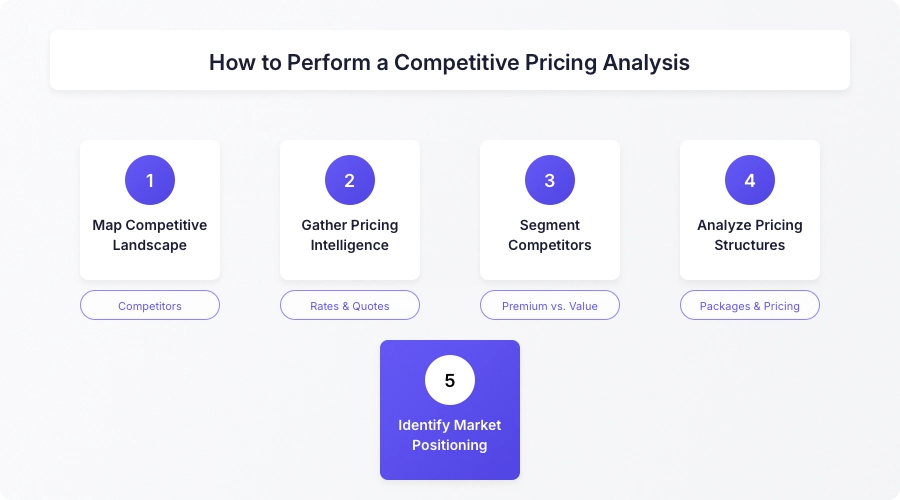
Implementation checklist
Use this checklist to ensure thorough implementation:
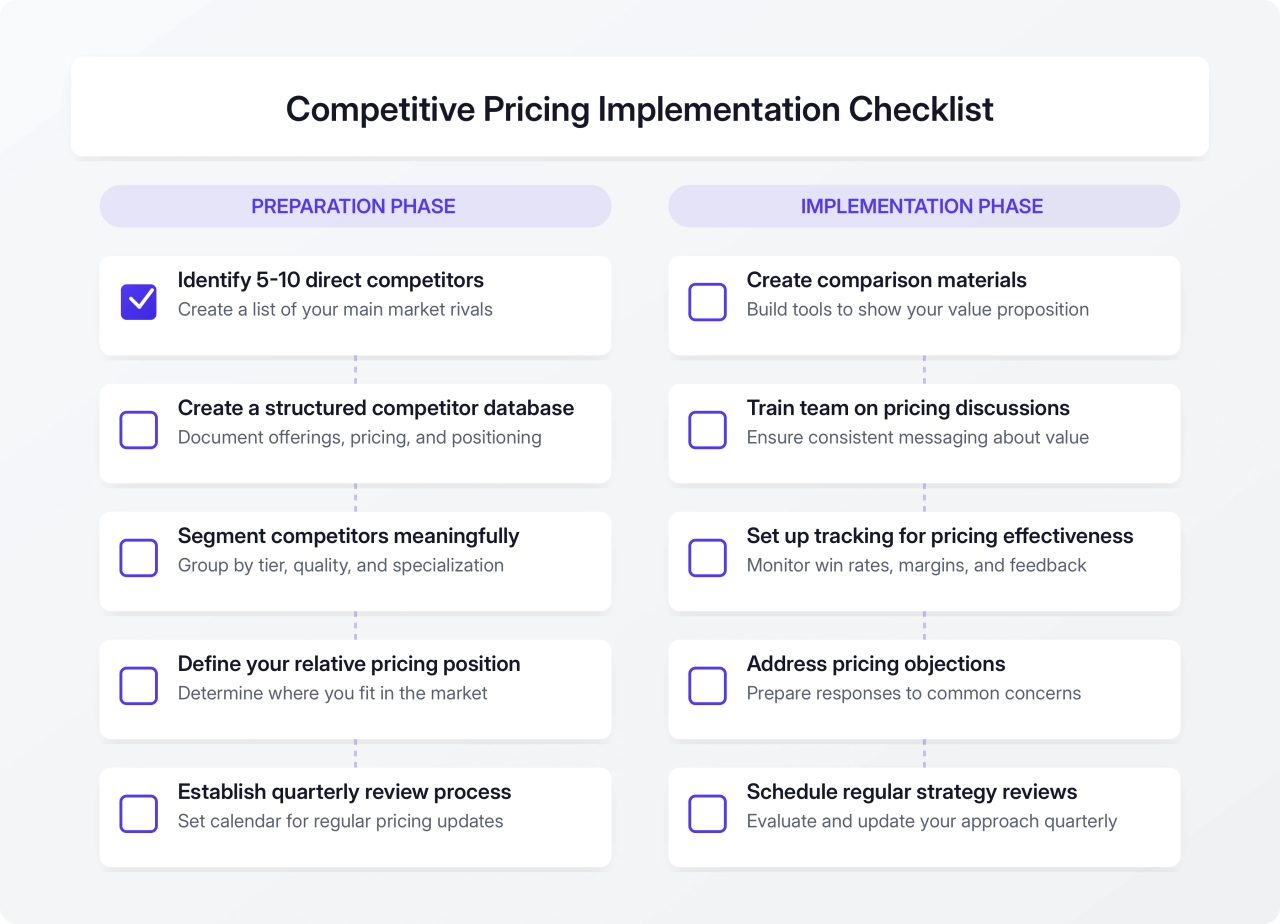
Key considerations for your implementation
Competitive pricing may seem straightforward, but successful implementation requires careful attention to five critical business factors that will determine whether this strategy helps your business thrive or struggle to remain profitable.
Production costs
Let’s assume it costs your competitors $100 to provide a service and they price it at $150. Setting your price at $140 might seem like a good idea to undercut them. However, this will only make sense if your production costs are lower than $100. If it’s more, you’ll struggle to become profitable and may have to sell a bigger volume to break even.
Profit margins
While it is essential to stay competitive, ensure your business remains profitable. Before adopting competitor’s prices, calculate your margins to determine the profit necessary to keep the company afloat. Establish a pricing floor based on your minimum acceptable margin, and be prepared to emphasize value when competitors drop below this threshold.
Target audience
Price isn’t the only factor customers consider when making purchasing decisions. Other factors like quality, brand reputation, social proof, and convenience also play significant roles. Understand your target audience’s buying behavior and what they value most. A client who appreciates quality over price will choose your business if you offer better quality, even at a higher price point.
Brand image & positioning
Your pricing should align with your brand positioning. Running a luxury business while adopting prices similar to budget brands can harm your premium status. Customers might assume you’ve reduced quality if your prices are unexpectedly low. Consider developing different service tiers if you want to capture different market segments without diluting your brand.
Long-term goals
Starting a business is the easy part—maintaining it over time is the challenge. Consider how your pricing strategy fits with your long-term objectives. Will it be sustainable? How will it affect your profitability, market share, customer base, and overall business growth as your business matures?
Does the competitive pricing strategy work for agencies?
As I’ve established throughout this article, competitor-based pricing is effective for businesses wanting to attract and retain price-sensitive customers. But is it right for service-based agencies?
The truth is, there’s no harm in researching your competitors to understand market rates. However, it may not be the optimal strategy for agencies because clients often prioritize quality, expertise, and results over the lowest price.
For agencies, competitive pricing works best when:
You have good automation and processes in place that allow you to deliver quality while maintaining healthy margins.
You’re entering a new market and need to establish a foothold.
You’re offering standardized, easily comparable services.
You have ways to clearly differentiate despite similar pricing.
Take Harry Strick, founder and CEO of Ranked.ai, as an example. He uses automation to streamline processes without compromising quality:
Structured pricing makes sense if you’re able to deliver a structured service that isn’t customized and work out the operational technicalities. For us, we do one singular workflow at scale for thousands of clients. Hire in-house and segment the service deliverables so that everyone focuses on one part. This allows us to scale to thousands of clients, be on time and improve quality. It also helps with margin expansion without the need to increase prices. We are in a unique position because we don’t have any CAC/sales expenses. I recommend agencies figuring out how much time they spend with the client and nurturing the relationship, and price accordingly for their time.
 Harry Strick,
Ranked.ai
Harry Strick,
Ranked.ai
Overall, the decision to use a competitive pricing strategy for agencies depends on the specific industry and target audience. Carefully consider all factors before adopting this pricing model to ensure they remain profitable without compromising quality.
Common challenges and solutions
Implementing competitive pricing isn’t always smooth sailing. Here are the roadblocks you’re likely to encounter and how to navigate around them.
Competitors keep lowering their prices
Solution: Don’t get caught in a race to the bottom. Instead, establish a pricing floor based on your minimum acceptable profit margin. If competitors dip below this, pivot to emphasizing your added value rather than matching their unsustainable prices. Create a simple one-pager that visually compares your comprehensive service against their stripped-down version.
Clients treat services as commodities
Solution: Implement a tiered service structure where only your entry-level offering uses competitive pricing. Make your premium tiers clearly distinct with high-value additions that can’t be easily compared. With each client interaction, emphasize your process and results rather than deliverables—these are harder for clients to directly compare against competitors.
Margins are suffering
Solution: Before making any further price adjustments, conduct an operational efficiency audit. Look for automation opportunities in your client onboarding, project management, and delivery processes. Many agencies discover they can reduce delivery time by implementing proper systems and templates, allowing them to maintain competitive pricing without sacrificing profits.
Difficulty keeping up with market research
Solution: Set up a quarterly competitive pricing review rather than constant adjustments. Use automated tools to alert you only when significant changes occur. For your most standardized services, create a simple spreadsheet where team members can input competitor pricing they encounter naturally during sales conversations, building your intel organically without dedicated research time.
Pricing strategy comparison matrix
When it comes to choosing the right pricing strategy, don’t fall into the trap of thinking it’s an all-or-nothing decision. The matrix below isn’t just for comparison—it’s a toolkit you can apply across different service offerings.
Pricing Strategy | Best For | Profit Potential | Client Perception | Example |
|---|---|---|---|---|
Competitive Pricing | Standardized services, established markets | Medium | Fair market value | A web design agency charging $3,000 for a basic website because that’s the local market rate |
Value-Based Pricing | Results-driven services with measurable ROI | High | Investment with returns | An SEO agency charging 10% of revenue increase attributed to their work |
New agencies establishing baseline | Low-Medium | Transparent relationship | A content agency charging $150/article based on writer costs plus 40% markup | |
Package Pricing | Scalable, repeatable services | Medium-High | Clear deliverables | A social media agency offering Bronze/Silver/Gold monthly packages |
I’ve seen many agencies successfully use competitive pricing for their standardized services, value-based pricing for their strategy work, and package pricing for their core deliverables. With that said, the key is alignment—match each service category to the pricing model that both attracts clients and protects your margins.
Is your current pricing approach working for every service you offer? Probably not. Review this matrix quarterly as your agency grows, and be willing to adjust based on real client feedback and conversion data. Remember, the most successful agencies aren’t stuck on a single pricing philosophy—they’re pragmatic about what works for each service line and client segment.
Finding your ideal pricing strategy
With that said, choosing the right pricing approach depends entirely on what you’re trying to accomplish with your agency. The strategy that works for a new market entrant won’t be the same as for an established premium brand.
Let’s look at which competitive pricing approach aligns with your specific business goals:
What is your primary business goal?
Competitive pricing toolkit for agencies
Let’s be honest—knowing your competitors’ prices is only half the battle. You also need a system to implement and manage your competitive pricing strategy effectively.
Below are a few tools you should check out in order to stay comopetitive.
Market research tools:
SpyFu ($39/month): Track competitor digital marketing spend
SimilarWeb (Free tier available): Analyze competitor traffic and engagement
Owler (Free): Competitor revenue estimates and company information
Price monitoring:
Prisync ($59/month): Automated competitor price tracking with alerts
Price2Spy ($25/month): Scheduled reports on competitor pricing changes
Pricing psychology resources:
Book: Priceless by William Poundstone: Learn psychological pricing triggers
PricingPsychology.com newsletter: Monthly updates on pricing strategy research
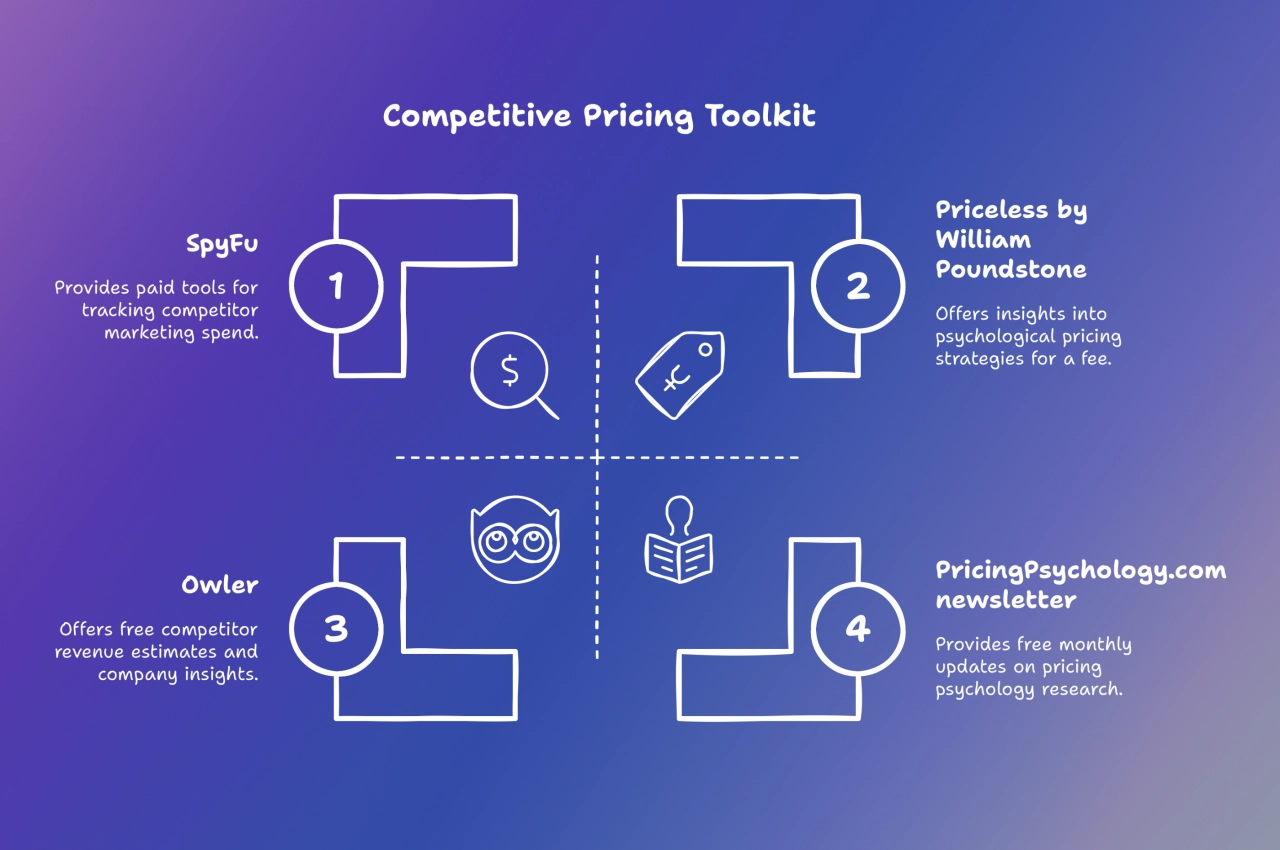
Remember, the goal isn’t just to match competitors—it’s to find that sweet spot where your pricing attracts clients while your efficiency delivers better margins than the competition. The right tools make all the difference in achieving this balance.
Frequently asked questions
What does competition-based pricing mean in marketing?
From a marketing perspective, competition-based pricing allows you to position your brand more easily compared to competitors, namely based on your price (lower, higher, the same). It serves as a straightforward positioning tool in your marketing messaging.
What companies use competition-based pricing?
Many companies use competition-based pricing, including those in retail (Walmart, Target), technology (PC manufacturers), and automotive industries. Service agencies in niches such as content writing, graphic design, and digital marketing often use this strategy for standardized services.
Why use competition-based pricing?
Competition-based pricing is useful because it allows businesses to stay competitive in the market without extensive pricing research. It provides a market-validated starting point and helps ensure your prices remain within customer expectations.
When is competition-based pricing most effective?
This approach is most effective when there are many competing firms in the market, when products or services are relatively standardized, and when prices are a primary factor that customers consider when making a purchase. It works well for new market entrants and businesses offering commoditized services.
Key takeaways
Implementing a competitive pricing strategy isn't about blindly matching your competitors—it’s about strategic positioning that makes sense for your specific service offerings.
For agency owners, the most practical approach is segmenting your services rather than applying one pricing strategy across the board. Your commodity services can use competitive pricing, while your specialized offerings should command premium rates.
Remember that operational efficiency is your secret weapon. The agencies that succeed with competitive pricing aren’t necessarily charging more—they’re delivering the same quality with less overhead through proper systems and automation.
Don’t fall into the race to the bottom trap. Always establish your pricing floor based on your minimum acceptable margins, and be ready to shift the conversation to value when competitors drop below it.
Disclaimer: This article provides general information about pricing strategies for service businesses. While we strive for accuracy, this content should not be considered financial advice. Every business has unique circumstances. We recommend consulting with a qualified financial professional or business advisor before making significant changes to your pricing strategy.




